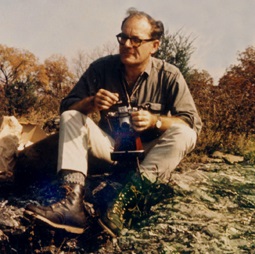A man of great dignity, admired for his skill as a first-rate scholar and teacher
 George Theokritoff, who died on 19 December 2015, was born in London on 7 April 1924, the youngest son of Lydia and Vladimir Theokritoff, sometime Deacon at the Chapel of the Imperial Russian Embassy in London. From an early age, he developed an interest in the natural world and (though his career was to be in science) music and his Orthodox Christian faith were major influences in his life. An accomplished horn and cornetto player, he had an encyclopaedic knowledge of classical music and period instruments.
George Theokritoff, who died on 19 December 2015, was born in London on 7 April 1924, the youngest son of Lydia and Vladimir Theokritoff, sometime Deacon at the Chapel of the Imperial Russian Embassy in London. From an early age, he developed an interest in the natural world and (though his career was to be in science) music and his Orthodox Christian faith were major influences in his life. An accomplished horn and cornetto player, he had an encyclopaedic knowledge of classical music and period instruments.
From Chelsea Polytechnic, he went on to study geology in the Royal College of Science of Imperial College, where he was awarded his BSc (Hons) ARCS in 1945. An enthusiast for fieldwork, he started a study of the Irish south-western sector of the Midland Valley structure with a view to a PhD, but lack of funds eventually caused him to submit the work for an MSc at Imperial instead. That study generated the important features of his geological career (i.e., trilobites, faunal realms, stratigraphy and tectonic structures) and led to his first publications.
In 1946, he contributed to a PGA article on The relationship of slaty cleavage and kindred structures to tectonics and, in 1949, read his paper Ordovician rocks near Leenane, Ireland at the Royal Irish Academy prior to publication in their 1951 Proceedings. Concurrent with such studies, George was a Demonstrator of Geology at Bedford College (1946 -1948).
In 1949, he was recruited by Imperial Oil Limited for field studies in the Ontario Michigan Basin and on the Pennsylvanian rocks of Maritime Canada. By 1951, he was an independent consultant for various companies with interests in the Basin and part-time lecturer in geology at the University of Western Ontario. It did not take him long to decide that the university environment was more congenial than industry, allowing him to apply his experience to instruction and research; there followed posts as Instructor of Geology in Mount Holyoke College, Massachusetts (1954-56) and Bucknell University, Lewisburg, Pennsylvania (1956-60). During those years, he undertook fieldwork in the Taconic Region of Vermont and New York and, in 1960, with a 20-month leave of absence from Bucknell and grants from the National Foundation and GSA Penrose Bequest, completed his thesis Stratigraphy and Palaeontology of the "Slate Belt" in the vicinity of Hampton in Washington County, New York for the University of London PhD.
This study, was greatly facilitated by the guidance of Marland Billings, Harry Whittington and James Thompson Jr. at Harvard University, where he held ‘special student status’. His continued summer fieldwork involved important collaboration with such eminent colleagues as B F Howell, C Lochman-Balk, F Rasetti, A R Palmer, W B N Berry, J M Bird, R B Neuman and E-an Zen and gave rise to very significant publications on the lithostratigraphical, biostratigraphical, trilobitic, graptolitic and structural features of the complex Taconic Region when the concept of an Iapetus [Proto-Atlantic] Ocean was proposed.
Following the appointment of Assistant Professor in the University of New Hampshire, a 2-year spell (1962-64) as a geologist with the Consumer Gas Co. in Toronto, and the post of Associate Professor at St. Lawrence University, Canton, NY (1964-67), he began his last posting in Rutgers ̶ The State University, Newark, NJ, where he taught until 1994, when appointed Emeritus Professor of Geology; on retirement, he continued his palaeontological research and published until 2008. Late in life, in 1990, George married Elizabeth Briere, whom he had met during a sabbatical in London.
Their shared interests included the intersection of environmental concerns and theology and led to regular trips to England and other travels for theological meetings, where his perspective from a background in Earth Sciences was welcomed with great interest. Thus encouraged, he became increasingly interested in the intersection and ‘congruence’ between science and theology, publishing several papers on the subject in retirement; he resolutely opposed the notion of a stark choice between creationism and scientism.
Always sensitive to natural beauty - captured in his many fine slides - George retained a lasting affection for many of the places, where he had done fieldwork, especially Leenane, Newfoundland and the Taconic region of New York (forever associated with the marmalade cat, Timothy, who shared his summer lodgings and sat on his maps). But most of all, he loved the coast of Maine, where he enjoyed summer-camping holidays from the 1970s until his 90th year – and once led a highly acclaimed field trip on ‘The palaeontology of the present’.
George was a modest man, who disliked the limelight and was always ready to credit his mentors and collaborators; but his contributions are regarded as outstanding by his peers and his dedication to critical synthesis much admired. His breadth of outlook, embracing many elements of human civilization, enhanced his teaching, for he made students aware of the methodology and history of Science and the broader cultural framework within which science operates.
An uncompromising champion of academic standards, he was also a popular professor, who was generous with his help and encouragement. Friends and acquaintances from all walks of life remember him warmly both for his fund of interesting stories and for his good humour, courtesy and gentleness.
Terence Fletcher and Elizabeth Theokritoff